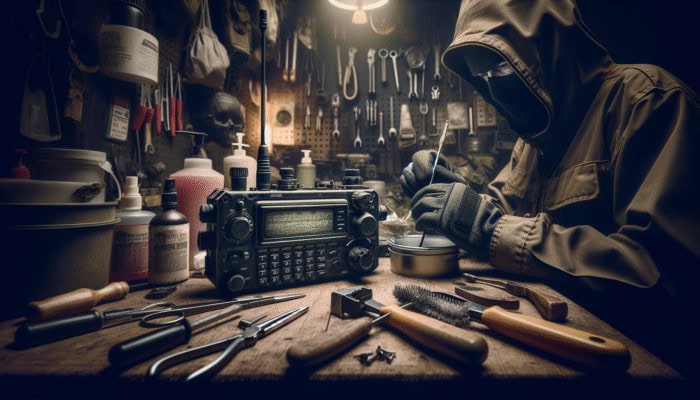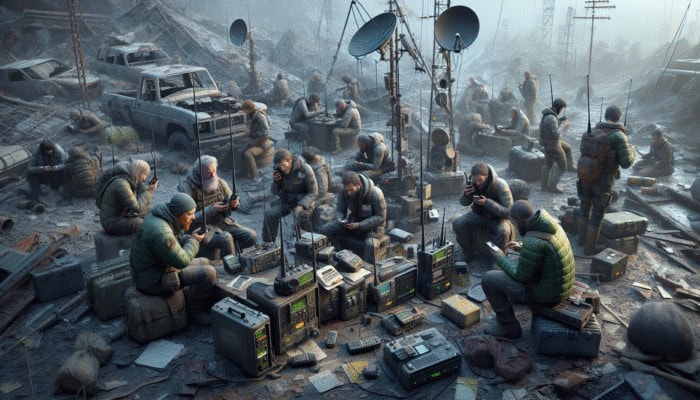Exploring Essential Communication Devices for Preppers
Prepper communication devices are indispensable for ensuring survival and effective coordination. These devices are specifically engineered to operate in situations where conventional communication networks may be compromised, thus providing critical links between individuals and groups. Gaining a comprehensive understanding of the various types of devices available, their significance, and best practices for their maintenance will empower preppers to make informed choices that significantly enhance their preparedness and resilience in challenging circumstances.
Exploring the Diverse Range of Communication Devices

The extensive variety of available prepper communication devices caters to a wide range of needs and preferences, ensuring that every prepper can find a suitable solution. Leading this diverse field are two-way radios, which include Walkie-Talkies and GMRS (General Mobile Radio Service) radios, allowing for short-range communication among groups. These devices are crucial during local emergencies, facilitating rapid coordination of efforts. For those who require communication over longer distances, ham radios provide a robust solution. Operating on amateur radio frequencies, these radios can transmit messages across vast distances, making them invaluable for emergency communications, particularly in remote or isolated areas.
Satellite phones are another essential device, ensuring reliable communication when terrestrial networks are disrupted. These phones establish direct connections to satellites orbiting the Earth, proving indispensable during natural disasters or in remote locations such as wilderness expeditions. Additionally, shortwave radios allow access to international broadcasts, including emergency alerts and news updates, making them a vital asset for staying well-informed amidst chaos and uncertainty.
The Critical Importance of Effective Communication
Effective communication during emergencies is critical; it can quite literally be a matter of life and death. In crises, the timely and clear exchange of information allows individuals to coordinate rescue efforts, make informed decisions, and stay aware of evolving threats. Prepper communication devices form the backbone for these essential interactions, enabling groups to maintain contact and share vital information that can affect their safety and survival.
Imagine a scenario where conventional communication systems fail due to a natural disaster. In such desperate circumstances, having dependable devices can facilitate evacuation plans, resource distribution, and updates on safety measures. Moreover, communication fosters a sense of community and support during crises, which can significantly alleviate stress and ensure a cohesive approach to overcoming challenges. By prioritising effective communication, preppers can enhance their chances of navigating emergencies successfully.
Determining the Most Suitable Communication Device
Choosing the right prepper communication device relies on several critical factors, including range, durability, and ease of use. Range is of utmost importance; devices should possess the capability to transmit signals over sufficient distances to cover the intended operational area. For instance, if a group is preparing for an extended camping trip in a remote wilderness area, they should opt for devices with long-range capabilities, such as ham radios or satellite phones.
Durability also plays a significant role, as the challenges encountered during emergencies can be severe. Devices must be able to withstand extreme weather conditions, moisture, and physical impacts. It is advisable to select options that are rated for rugged environments or designed explicitly for outdoor use. Lastly, ease of use is vital; overly complex devices may hinder communication in high-pressure situations. User-friendly interfaces and intuitive controls can make a considerable difference when every second counts during an emergency.
Essential Maintenance Practices for Communication Devices

To guarantee that prepper communication devices remain in optimal working condition, regular maintenance is critical. This includes routine inspections for any damage, functionality testing, and thorough cleaning. Dust and moisture can severely impair devices, potentially leading to failures at the most critical times. For example, if a radio has been exposed to harsh weather, moisture can corrode internal components, rendering it unusable.
Battery management is another crucial aspect of device maintenance. Many communication devices rely on batteries, which can degrade over time. Regularly checking battery health and ensuring that spare batteries are readily available can prevent potential communication failures. For devices that support rechargeable batteries, establishing a charging routine, especially with solar chargers, can significantly extend their operational lifespan and reliability during emergencies.
Establishing Effective Communication Protocols for Preppers
Establishing clear communication protocols is fundamental for prepper communication devices to function effectively. Protocols should define how devices are used, including when to communicate, what types of information should be shared, and how to signal emergencies. This becomes particularly important in group scenarios where multiple individuals depend on one another for safety and coordination.
Training sessions should incorporate drills that practice these protocols, ensuring that every member understands their specific roles and responsibilities. Furthermore, implementing a code system for communication can enhance security, safeguarding sensitive information from potential interception. By investing time and resources into these protocols, preppers can ensure a streamlined and efficient exchange of information during emergencies, ultimately improving their chances of survival and success.
Maximising Radio Communication for Preppers
Within the spectrum of prepper communication devices, radio communication stands out as a powerful solution for maintaining contact during emergencies. Various forms of radio technology cater to different communication needs, ranging from short-range family communication to long-distance emergency broadcasts, which are essential for those preparing for unexpected situations.
Utilising Ham Radios for Long-Distance Communication

Ham radios, also known as amateur radios, serve as a lifeline for long-distance communication. They operate on specific frequencies allocated for non-commercial use, enabling users to connect over vast distances, often reaching hundreds of miles. This capability is particularly beneficial during emergencies when other forms of telecommunication may be unavailable or compromised.
One of the most significant advantages of ham radios is their independence from conventional commercial networks. During disasters, when infrastructure may be severely compromised, ham radio operators can establish their networks, providing critical communication links that are essential for effective disaster response. Numerous ham operators participate in emergency communication groups that assist in coordinating rescue efforts and disseminating vital information to affected areas, making them invaluable resources.
To operate a ham radio effectively, proper training and licensure are required, which adds a layer of responsibility. However, the investment in learning can pay off tremendously during critical situations. Mastering the use of this technology means being equipped to call for help or provide assistance to others in distress, solidifying ham radios as a cornerstone of effective emergency communication.
GMRS Radios for Family and Group Communication
General Mobile Radio Service (GMRS) radios are specifically tailored for family and group communication, making them ideal for preppers who aim to maintain contact during localized emergencies. GMRS radios operate on designated UHF frequencies and provide a more extended range compared to standard walkie-talkies, often reaching several miles depending on terrain and conditions.
One of the standout features of GMRS radios is their ease of use. Most models are pre-programmed with channels, allowing users to communicate with minimal setup. This user-friendliness makes GMRS radios accessible to a wide audience, ensuring that even those with limited technical expertise can maintain contact during crises.
Additionally, GMRS radios support repeaters, which can significantly extend their range. Preppers can establish a repeater station to amplify signals, ensuring communication over larger distances and enhancing group coordination. For families venturing into the wilderness or preparing for potential urban challenges, GMRS radios offer a versatile communication solution that is both effective and reliable.
The Value of Shortwave Radios in Emergencies
Shortwave radios are an essential component of prepper communication devices due to their capability to capture international broadcasts and emergency alerts. By receiving signals that bounce off the ionosphere, these radios can connect users to a wealth of information from around the globe, including news updates and critical emergency announcements.
During significant events, such as natural disasters, political unrest, or other global incidents, access to accurate information is crucial. Shortwave radios can provide updates on evolving situations, enabling preppers to make informed decisions about their safety and required actions. Additionally, many shortwave radios come with features like USB charging ports, allowing users to power their devices even during extended outages, which further adds to their utility.
There is also a strong community aspect to the use of shortwave radio. Operators frequently exchange information and updates with one another, forming a network that promotes collaboration and mutual support. For preppers, engaging with this community can enhance their knowledge and preparedness, making shortwave radios a multifaceted resource for communication and information dissemination.
Exploring Satellite Communication Options
When conventional communication channels become compromised, satellite communication options emerge as reliable lifelines for preppers. These devices provide crucial connectivity, enabling individuals to stay in touch even in the most remote or disaster-affected areas.
The Indispensable Role of Satellite Phones
Satellite phones are essential for maintaining communication when terrestrial networks are unavailable. Unlike traditional cell phones that rely on cellular towers, satellite phones connect directly to satellites, ensuring a signal even in the most isolated locations. This capability is particularly vital for preppers engaging in outdoor activities or residing in areas that are prone to natural disasters.
The reliability of satellite phones during emergencies is crucial and cannot be overstated. They facilitate voice calls and, in many cases, text messaging, providing essential lines of communication with emergency services or loved ones. However, it is crucial to understand the operational requirements, such as maintaining a clear line of sight to the sky, as obstructions can significantly impact signal quality.
When selecting a satellite phone, preppers should consider features such as battery life, durability, and additional functionalities, including GPS tracking. Many satellite phones are designed to withstand harsh conditions, making them ideal companions for outdoor adventures or emergency preparedness. Investing in this technology represents a commitment to maintaining dependable communication in the face of chaos and uncertainty.
Satellite Messengers for Quick Communication
Complementing satellite phones, satellite messengers are compact devices specifically designed to send and receive text messages and GPS coordinates, even in the most remote locations. They leverage satellite connectivity to provide a user-friendly solution for rapid communication when traditional methods are insufficient.
One of the key advantages of satellite messengers is their versatility. Many feature SOS buttons that can send distress signals along with GPS coordinates to emergency responders, which can be invaluable in life-threatening situations. This functionality allows preppers to communicate their location and request assistance, thereby enhancing their safety during emergencies.
Moreover, many satellite messengers come with features that enable users to send messages to family and friends, ensuring that loved ones are kept informed about their well-being. This capability alleviates stress and fosters a sense of connection, even when separated by vast distances. For preppers venturing into the wilderness or preparing for potential disasters, satellite messengers represent a crucial addition to their communication toolkit, significantly enhancing their overall preparedness.
Satellite Internet for Reliable Connectivity
In an increasingly interconnected world, satellite internet services are revolutionising how preppers maintain connectivity during long-term emergencies. These services provide reliable internet access, even in areas where traditional broadband options are unavailable, ensuring that users can access vital information and resources.
The importance of satellite internet becomes apparent during crises when updates on weather conditions, emergency services, and safety protocols are critical. With satellite internet, preppers can access online tools and resources that help them plan and execute effective response strategies. This connectivity can be pivotal for families, enabling them to stay informed and make informed decisions in real-time, which is crucial for their safety and well-being.
When selecting a satellite internet service, consider factors like data limits, connectivity speed, and overall reliability. Some providers offer portable options, meaning preppers can maintain connectivity while on the move. Investing in satellite internet capabilities not only enhances a prepper’s readiness but also fosters adaptability during crises, empowering individuals and families to remain informed and connected, regardless of the circumstances.
The Advantages of Satellite Broadband Systems
Satellite broadband is a powerful extension of satellite connectivity, offering high-speed internet access in areas where traditional infrastructure is limited or unavailable. For preppers, this technology translates to enhanced communication capabilities, allowing users to access vital information, coordinate with others, and share updates during emergencies.
Similar to conventional broadband, satellite broadband supports a variety of online activities, from browsing news websites to streaming educational content. This connectivity is crucial during emergencies, ensuring that preppers can access real-time information about evolving situations. Many satellite broadband services are designed to work seamlessly with existing devices, making integration straightforward and user-friendly, enhancing the overall user experience.
Furthermore, maintaining a reliable internet connection can significantly impact a prepper’s mental well-being during extended emergencies. Access to news, entertainment, and communication with loved ones can alleviate feelings of isolation and anxiety, contributing to overall resilience. Satellite broadband systems represent a strategic investment in preparedness, ensuring that individuals and families can remain informed and connected, no matter the circumstances they face.
Utilising Satellite TV Services for Information and Entertainment
During extended emergencies, when conventional media may be disrupted, satellite TV services provide a crucial source of entertainment and information. These services provide access to a diverse range of channels, ensuring that viewers can stay informed about news, weather, and emergency-related announcements.
One of the primary advantages of satellite TV is its resilience against disruptions. Unlike traditional cable systems, satellite TV relies on signals from satellites, making it less susceptible to outages caused by adverse weather events or infrastructure damage. For preppers, having access to dependable news and updates can be critical for making informed decisions during crises, thereby enhancing their preparedness and response capabilities.
Moreover, satellite TV can serve as a significant morale booster during challenging times. Access to entertainment options can alleviate stress and provide a sense of normalcy amid chaos. Preppers should consider investing in portable satellite TV systems, which can be set up quickly in various environments, further enhancing their adaptability and communication capabilities during emergencies.
Harnessing Mobile Apps for Enhanced Preparedness
As technology continues to advance, mobile apps have emerged as invaluable tools for preppers, providing real-time communication and situational awareness. These applications significantly enhance preparedness by equipping individuals with essential information and connectivity options during emergencies.
Leveraging Emergency Alert Apps for Timely Information
Emergency alert apps are designed to provide real-time information and warnings during disasters. These applications utilise data from various sources to keep users informed about severe weather alerts, natural disasters, and other critical events that may pose a safety risk.
For preppers, the significance of these apps lies in their ability to deliver timely notifications directly to users’ devices. This immediacy can be life-saving, enabling individuals to take quick action in response to imminent threats. Many emergency alert apps also provide safety tips and resources, empowering users to prepare for various scenarios and make informed decisions that can significantly affect their safety.
Moreover, some apps allow users to customize alerts based on their geographic location or specific interests, ensuring that they receive the most pertinent and relevant information. By integrating these emergency alert apps into their communication strategy, preppers can stay one step ahead, enhancing their awareness and overall readiness in times of crisis.
Offline Messaging Apps for Resilient Communication
In scenarios where internet or cellular service is unavailable, offline messaging apps can be a game-changer for maintaining communication. These applications utilise Bluetooth and local Wi-Fi networks to enable users to send and receive messages without relying on traditional telecom infrastructure.
For preppers, having access to offline messaging capabilities means maintaining communication with group members even when conventional networks fail. This can be particularly useful during natural disasters or remote expeditions, where connectivity may be compromised. Apps like FireChat and Briar enable users to create mesh networks, facilitating communication without an internet connection, thereby enhancing their overall preparedness.
Additionally, offline messaging apps often prioritise security, encrypting messages to protect against unauthorized access. This aspect is crucial for preppers concerned about privacy during emergencies. By integrating offline messaging apps into their communication arsenal, preppers can ensure that they remain connected, informed, and secure when it matters most, thereby enhancing their overall resilience.
Map and Navigation Apps for Emergency Situations
Map and navigation apps are indispensable tools for preppers, providing crucial support for planning and movement during emergencies. These applications offer detailed maps, route suggestions, and real-time navigation assistance, helping individuals navigate unfamiliar terrains or optimise evacuation routes effectively.
During emergencies, having access to accurate information about safe routes and locations can be vital for survival. Mapping applications, such as Google Maps and various offline alternatives, enable preppers to identify critical resources, including shelter, food, and medical assistance. This capability can significantly impact the difference between safety and peril in rapidly changing situations, making these tools essential for effective emergency preparedness and response.
Moreover, many navigation apps allow users to share their locations with trusted contacts, enhancing group coordination during crises. This feature fosters a sense of community and support, ensuring that everyone can stay informed and connected. By leveraging map and navigation apps, preppers can enhance their decision-making capabilities and improve their overall readiness for emergencies, thereby increasing their chances of survival.
Powering Your Essential Communication Devices
The efficiency of prepper communication devices relies not only on their technology but also on their power sources. Ensuring that these devices remain powered during emergencies is crucial for effective communication and overall preparedness.
Exploring Battery Options for Communication Devices
When selecting batteries to power prepper communication devices, understanding the various types available is essential for optimal performance. Common battery types include alkaline, lithium-ion, and rechargeable batteries, each offering unique advantages and limitations. Alkaline batteries are widely available and effective for short-term use, but they may not be suitable for prolonged emergencies due to their limited longevity.
In contrast, lithium-ion batteries offer superior performance, with longer lifespans and the ability to hold a charge for extended periods. This makes them an excellent choice for devices that may not be used regularly. For preppers investing in rechargeable communication devices, lithium-ion batteries are typically the best option, as they can be recharged multiple times without significant degradation in performance.
Additionally, having a variety of battery sizes on hand ensures flexibility for different devices. Preppers should also consider investing in battery management systems that monitor battery health and performance, allowing for timely replacements and maintenance, which is essential for ensuring that devices remain functional during critical situations.
Utilising Solar Chargers for Sustainable Power
Solar chargers are a crucial component of a prepper’s power strategy, providing a sustainable and renewable energy source during prolonged power outages. These chargers utilise solar panels to convert sunlight into electricity, allowing users to recharge their communication devices without relying on traditional power sources.
The versatility of solar chargers makes them particularly appealing for preppers. They are portable, enabling users to charge devices in remote locations while on outdoor adventures or during emergencies. Many solar chargers come equipped with multiple ports, allowing for the simultaneous charging of several devices, thus enhancing their utility and practicality.
When selecting a solar charger, consider factors such as wattage and compatibility with your devices. High-capacity chargers may be necessary for power-hungry devices, while smaller units can suffice for basic needs. Investing in solar chargers ensures that preppers maintain critical communication capabilities even in the face of prolonged power outages, thereby enhancing their overall preparedness.
Hand-Crank Generators for Emergency Power
Hand-crank generators serve as a reliable backup power source for prepper communication devices, providing an invaluable solution for maintaining connectivity when conventional power sources are unavailable. These generators convert mechanical energy into electrical power, allowing users to generate electricity by simply cranking a handle.
One of the primary advantages of hand-crank generators is their independence from fuel sources. In emergencies where gasoline or propane may be scarce, hand-crank generators ensure that users can still generate power. This technology is beneficial for preppers focused on self-sufficiency and sustainability, reinforcing their preparedness strategies and enhancing their overall resilience.
Moreover, hand-crank generators are typically compact and portable, making them easy to transport and store. They can power essential communication devices such as radios, phones, and GPS units, ensuring that preppers remain connected and informed during crises. By incorporating hand-crank generators into their power strategy, preppers enhance their resilience and adaptability in the face of unexpected challenges.
Securing Your Communication Channels
As communication technology evolves, so too do the threats to information security. For preppers, ensuring the security of their communications is essential to protect sensitive information and maintain coordination during emergencies.
Implementing Encryption Methods for Enhanced Security
Employing encryption methods is a critical strategy for safeguarding communications from unauthorized access. Encryption transforms information into unreadable code, ensuring that only authorized parties can access the contents. For preppers, this means protecting sensitive details about locations, resources, and strategies during emergencies.
Various encryption techniques are available, ranging from simple password protection for messaging apps to complex encryption algorithms used in specialised communication devices. Preppers should prioritise tools and platforms that offer robust encryption features, ensuring that their communications remain private and secure.
Additionally, understanding the limitations of encryption is vital. While it can significantly enhance security, it is not foolproof. Preppers should combine encryption with other security practices, such as using secure messaging platforms and implementing strong password management strategies to ensure comprehensive protection of their communications.
Ensuring Radio Frequency Privacy
When using radio communication devices, minimising the risk of interception is crucial. Radio signals can be picked up by anyone with the proper equipment, making it essential for preppers to take proactive measures to protect their communications.
One effective strategy is to implement coded language or signals within group communications. This practice can obfuscate the contents of messages, making it difficult for unauthorized listeners to comprehend the information being exchanged. Regularly rotating codes can further enhance security by keeping potential interceptors guessing and protecting sensitive information.
Consideration of radio frequency privacy is also vital during emergencies. Preppers should select communication devices that operate on secure frequencies and refrain from using public channels for transmitting sensitive information. By prioritising radio frequency privacy, preppers can ensure that their communications remain secure and effective during crises, ultimately enhancing their chances of survival and success.
Utilising Secure Messaging Platforms for Confidential Communication
Secure messaging platforms are essential tools for preppers seeking privacy and security in their communications. These platforms utilise encryption and other security measures to protect user data, ensuring that sensitive information remains confidential.
Popular secure messaging apps, such as Signal and WhatsApp, offer end-to-end encryption, meaning that only the sender and recipient can access the content of messages. This feature is particularly crucial for preppers discussing strategies, resources, or sensitive information during emergencies, as it ensures that their communications are protected from prying eyes.
Additionally, secure messaging platforms often provide features such as self-destructing messages and anonymity, thereby enhancing user privacy. By integrating these platforms into their communication strategies, preppers can ensure that their exchanges remain confidential and secure, fostering trust and cooperation within their groups, which is vital during emergencies.
Training and Practicing Communication Skills
Even the best prepper communication devices require proper training to be effective. Regular practice and skill development ensure that preppers are prepared to utilise their devices efficiently during actual emergencies, which can significantly enhance their chances of survival.
Conducting Regular Communication Drills
Conducting regular communication drills is essential for ensuring that preppers are ready to respond effectively during emergencies. These drills simulate real-life scenarios, allowing individuals to practice using their communication devices and reinforce established protocols.
Drills can range from simple exercises, such as testing communication ranges and functionalities, to more complex simulations involving multiple group members. Practising these scenarios helps identify potential weaknesses in communication strategies and allows preppers to refine their approaches, ensuring that they are well-prepared for any situation.
Moreover, communication drills foster teamwork and collaboration, ensuring that every member understands their role in an emergency. This readiness can significantly enhance the effectiveness of communication efforts during crises, ultimately improving outcomes for everyone involved.
Developing Essential Skills for Device Operation
Developing the necessary skills to operate various prepper communication devices is vital for ensuring effective usage during emergencies. This skill development encompasses understanding the technical aspects of devices, including settings, functionalities, and troubleshooting techniques.
Training sessions should focus on familiarising users with the devices they will rely on during emergencies. For instance, individuals should practice setting up and using ham radios, GMRS radios, and satellite phones, ensuring they can operate them intuitively when needed.
Additionally, exploring online resources, workshops, and community training can enhance knowledge and skills. By investing time in skill development, preppers can ensure that they are equipped to utilise their communication devices effectively, maximising their chances of success during emergencies and enhancing their overall preparedness.
Engaging in Scenario-Based Training
Scenario-based training is an effective method for preparing preppers for real-world communication challenges. By creating simulations that mimic potential emergencies, preppers can effectively practice their responses and refine their communication strategies.
These scenarios can encompass various factors, including limited time, unexpected disruptions, and changing conditions. For example, a training exercise might involve a sudden weather event that disrupts communication channels, requiring participants to adapt quickly and utilise alternative devices or methods.
Engaging in scenario-based training fosters critical thinking and adaptability, ensuring that preppers are prepared to think on their feet when faced with uncertainties. By practising these strategies, preppers develop the skills necessary to navigate challenging situations and maintain effective communication during crises, ultimately improving their chances of survival and success.
Implementing Regular Evaluation and Feedback Mechanisms
Regular evaluation and feedback are integral components of effective training for prepper communication devices. Assessing performance during drills and training exercises enables individuals to identify their strengths and areas for improvement, ultimately enhancing their communication effectiveness.
Feedback mechanisms can include peer assessments, self-reflection, and group discussions focused on communication strategies. By creating an open environment for sharing insights and experiences, preppers can learn from one another and refine their tactics, ensuring that everyone is on the same page.
Incorporating evaluations into regular training routines ensures that preppers remain vigilant and adaptable. As conditions change, so too should communication strategies, making ongoing evaluation a cornerstone of effective preparedness and enhancing overall readiness during emergencies.
Keeping Your Devices in Optimal Condition
Proper maintenance of prepper communication devices is essential for ensuring they remain operational when needed most. Regular upkeep can prevent malfunctions and prolong the lifespan of devices, significantly enhancing overall preparedness and response capabilities.
Conducting Routine Inspections
Conducting regular inspections of communication devices is vital to ensure functionality and readiness. Preppers should establish a routine for inspecting devices for wear and tear, ensuring that all components are functioning correctly. Look for signs of damage, corrosion, or battery depletion—these issues can compromise performance during emergencies and must be addressed promptly.
Inspections should also include testing device capabilities, such as range and clarity of communication. Regularly using the devices in varied conditions will help users become familiar with their performance limits, ensuring they understand how far they can communicate effectively.
By prioritising regular inspections, preppers can stay ahead of potential issues and ensure their communication devices are ready for use whenever necessary, enhancing their overall preparedness and response strategies.
Implementing Proper Cleaning Techniques
Cleaning communication devices is a crucial maintenance step that is often overlooked. Dust, grime, and moisture can accumulate on devices, impacting their performance and longevity. Implementing proper cleaning techniques ensures that devices remain functional and reliable over time.
Begin by following the manufacturer’s guidelines for cleaning, ensuring that no moisture enters sensitive components. Use soft cloths and gentle cleaning solutions to wipe down surfaces, focusing on buttons and connectors. For devices exposed to outdoor elements, additional attention may be required to prevent corrosion and damage, which can compromise their effectiveness during emergencies.
Routine cleaning not only enhances device performance but also contributes to the overall hygiene and usability of communication tools. Preppers should incorporate cleaning into their maintenance schedules to ensure their devices remain in optimal condition, ready for any situation that may arise.
Staying Updated with Software Maintenance
Keeping the software of communication devices up to date is essential for enhancing security and functionality. Manufacturers often release updates that address security vulnerabilities, improve performance, and introduce new features.
Preppers should regularly check for software updates and ensure that their devices are running the latest versions. This practice helps prevent potential security breaches and enhances the overall user experience. Additionally, some devices offer automated updates, allowing preppers to set their systems to update automatically, thus reducing the burden of manual checks and ensuring they are always equipped with the latest tools and protections.
By prioritising software maintenance, preppers can ensure their communication devices are optimised for performance and security, ultimately enhancing their preparedness for emergencies and unexpected situations.
Frequently Asked Questions
What are prepper communication devices?
Prepper communication devices are tools designed for effective communication during emergencies, ensuring connectivity when traditional networks are unavailable or fail. These devices include radios, satellite phones, and messaging apps, enhancing coordination and information exchange among individuals and groups.
Why is communication important during emergencies?
Effective communication is crucial for survival in emergencies. It facilitates coordination, information sharing, and decision-making, helping individuals and groups respond effectively to threats and challenges that may arise during crises.
What types of radios are suitable for preppers?
Suitable radios for preppers include ham radios for long-distance communication, GMRS radios for family coordination, and shortwave radios for accessing international broadcasts and emergency alerts, which are vital for staying informed during emergencies.
How do satellite phones work?
Satellite phones connect directly to satellites orbiting the Earth, allowing users to communicate even when terrestrial networks are down. They are essential for reliable communication in remote areas or during disasters, ensuring that individuals can stay connected.
What are the benefits of using emergency alert apps?
Emergency alert apps provide real-time information and warnings during disasters, helping users stay informed about evolving threats and necessary actions. They enhance preparedness and response capabilities, ensuring that individuals are ready to act when needed.
How can I keep my communication devices powered?
You can power communication devices using various battery options, solar chargers, and hand-crank generators. Each option offers unique benefits, ensuring that devices remain operational during emergencies, which is crucial for effective communication.
What is the importance of encryption for communication?
Encryption protects communications from unauthorized access, ensuring that sensitive information remains confidential and secure. For preppers, utilising encrypted communication tools is vital for security during emergencies, safeguarding their strategies and resources from prying eyes.
Why should I conduct communication drills?
Conducting communication drills ensures readiness during emergencies by allowing preppers to practice using their communication devices and refine established protocols. They enhance coordination and effectiveness in real-life situations, ultimately improving outcomes for everyone involved.
How often should I inspect my communication devices?
Regular inspections should be conducted routinely—ideally every few months or before significant trips—to ensure communication devices are functional and free from damage, maximising readiness and effectiveness during emergencies.
What maintenance practices should I follow for my devices?
Regular maintenance practices include conducting inspections, cleaning devices, keeping software up to date, and managing battery health. This ensures optimal performance and longevity of communication tools, which is essential for effective preparedness.
Explore our world on X!
Survival Tent Options: Your Ultimate Guide
Explore the Different Types of Survival Tents for Your Adventures Discover the Benefits of Dome Tents for Outdoor Enthusiasts Survival Tent Options: Dome tents have gained immense popularity among outdoor enthusiasts, primarily for their outstanding stability and spacious interiors. Featuring a unique curved structure, these tents offer exceptional wind resistance and significant internal volume, making […]
Surviving Without Fuel: Essential Strategies
Exploring the Fundamentals of Fuel-Free Living What Is the Concept of Living Without Fuel? Surviving Without Fuel: The concept of living without fuel centers on the pivotal goal of significantly reducing or entirely eliminating our dependence on conventional energy sources, such as gasoline and diesel. This lifestyle choice underscores the importance of adopting sustainable alternatives […]
Grid-Down Survival: Essential Strategies for Resilience
Effective Strategies for Preparing for Grid-Down Scenarios Building a Comprehensive Stockpile of Essential Supplies Grid-Down Survival: To thrive during a grid-down scenario, building a comprehensive stockpile of essential supplies is crucial for your survival and that of your family during prolonged power outages. The strategy involves gathering a diverse assortment of items that meet fundamental needs such […]
Prepper Relocation Guide: Universal Strategies
Crucial Factors to Consider When Relocating for Preparedness Key Influences on Relocation Choices Prepper Relocation Guide: When contemplating a relocation for preparedness, it is essential to conduct a detailed assessment of various personal and situational elements. One of the primary considerations is to evaluate individual needs and preferences. These can encompass factors such as family […]








This is such an important topic—communication often gets overlooked in prepper discussions! For me, two-way radios have been a game changer, especially during family camping trips. It’s comforting to have that direct line with everyone, especially if we’re exploring different trails. I’ve found that understanding the range limitations is crucial, though. Last summer, we ventured a bit too far from each other, and communication dropped out, which was a bit nerve-wracking.